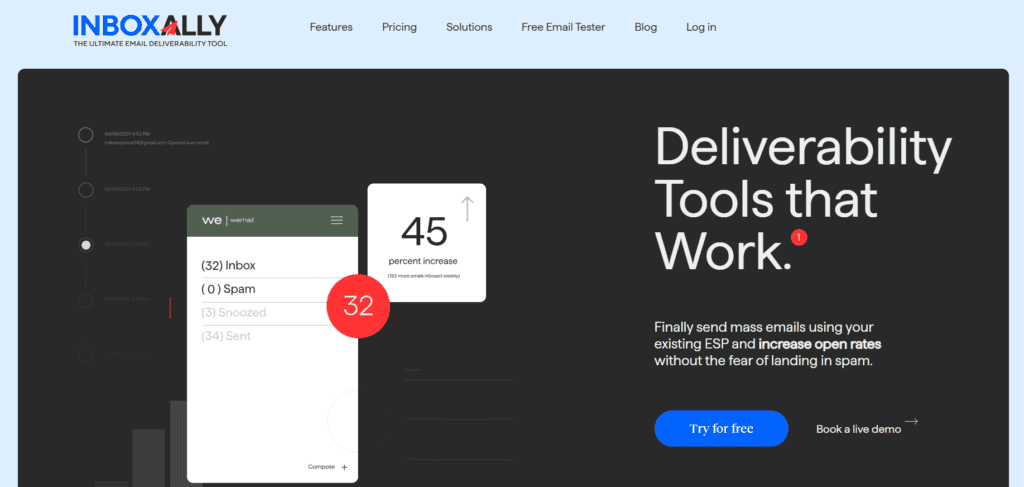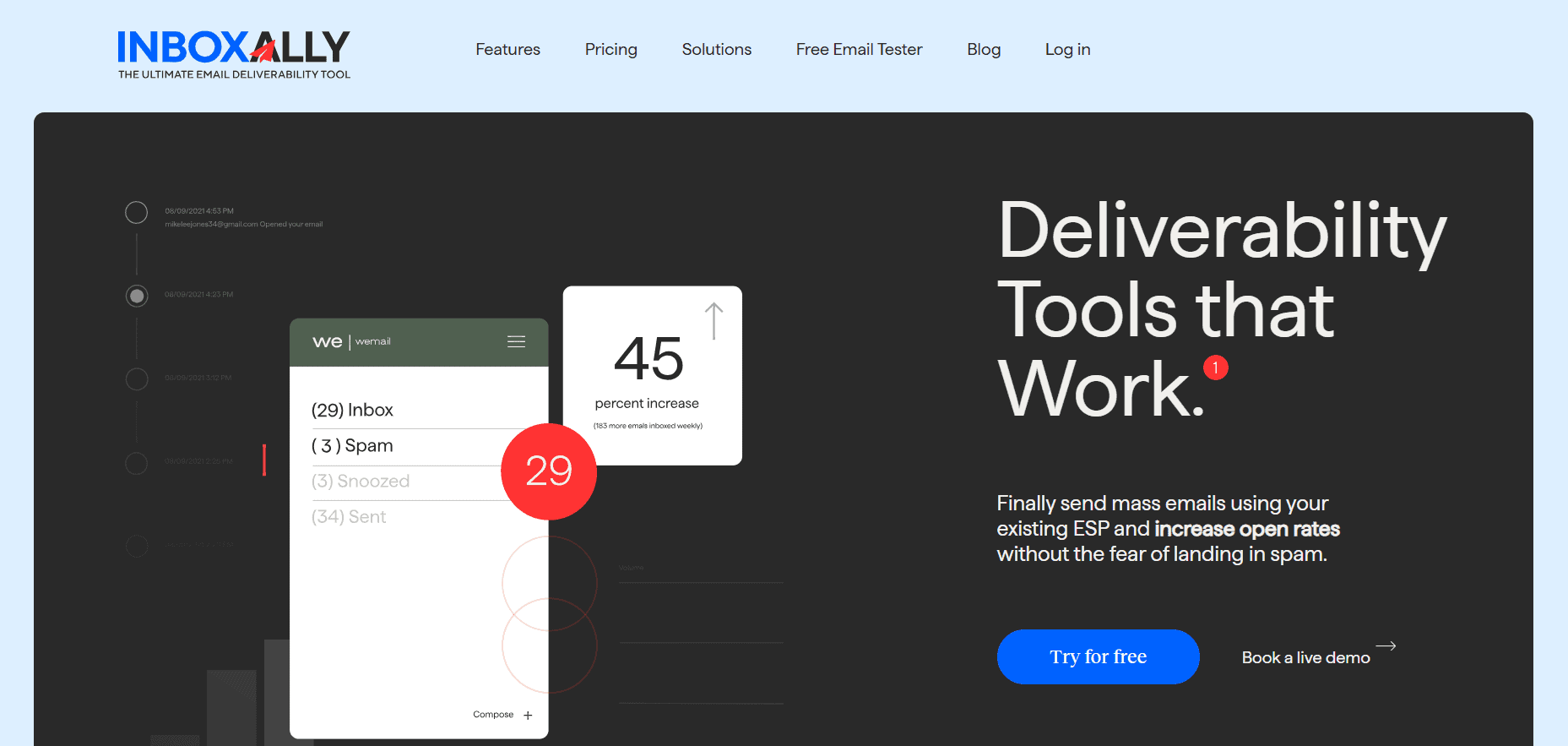Last Updated on October 21, 2025 by Ewen Finser
If you’re running a business or marketing agency that relies on email to reach your audience then choosing the right tool is crucial.
MailMonitor is a well-known and trusted solution for inbox placement and sender reputation monitoring. Still, it’s not your only choice.
Whether you’re looking for more advanced analytics, something that better fits your company’s workflow, or just want to save a few bucks on subscriptions, there are several strong alternatives.
The Best Alternative (The Quick Answer)
InboxAlly beats MailMonitor by a mile in my opinion. It uses real engagement techniques to warm up your sender reputation and improve inbox placement in real-time, which helps ISPs recognize your emails as legitimate. This is something MailMonitor skips entirely.
Top MailMonitor Alternatives
1. Warmy

Key Features:
- Warms up your email domain and IP
- Comprehensive deliverability of email metrics
- Customizable languages & topics
- Automates warm up tasks
As the name suggests, Warmy specializes in automated inbox warm up, as well as better deliverability.
Its dashboard is intuitive to use. The overall design of the platform is to mimic genuine user behavior e.g. by helping new/blocked domains build a good reputation with inbox providers, and it does this well.
You can monitor the success of your campaigns via built-in tools like the ‘the ‘Email Template Checker’. This can check your template for parameters like subject length, word count, reading time, the number of links in the message, question count, and even the ‘spammy’ word count.
Who it’s for:
Businesses that are launching new domains, recovering from previous deliverability issues, or are trying to run cold email campaigns at scale.
Pricing:

Warmy offers a 7-day free trial. No credit card is required. There are two main pricing plans.
‘B2B Sender’ uses a network of business mailboxes to reach professional providers using platforms like Google Workspaces and MS365. The ‘B2C Sender’ pricing plan focuses more on consumer mailboxes to reach personalized providers like Yahoo and Gmail.
Both plans follow a volume-based pricing model, so you’ll need to contact the Warmy sales team for a product demo and quote.
2. InboxAlly
Key Features:
- Landing tracking for emails (past 30 days)
- Preset engagement profiles
- Works with any e-mail sending service
- Powerful dashboard
As you’ll have seen above, I chose InboxAlly as the best MailMonitor alternative mainly due to its ability to actively ‘train’ popular inbox providers like Google that your messages are the type the recipient wants to read.
One of the main draws of InboxAlly is it works with any platform you use to send emails, without handing over your credentials. It supports most major mailbox providers including Gmail, Yahoo, Google Workspaces, Outlook, and Hotmail.
InboxAlly is the comprehensive suite I need to solve challenging deliverability problems across the board. It's like a triage hub for diagnosing and fixing email deliverability rates in one dashboard. I've tried a lot of tools, but this is the one I've stuck with.
The dashboard is a breeze to navigate, and setup takes around five minutes. The sheer number of tools is a little overwhelming at first but they’re logically laid out.
All plans include support for setting your own timezone and sending schedule. You can also upload your own email list, which can then be automatically verified for duplicate or incorrectly formatted addresses.
There are also built-in testers for your email subject line and body. These can identify spammy words, then automatically make suggested tweaks to the wording to keep your messages out of the junk folder.
Who it’s for:
Any marketers, agencies, or businesses that are struggling with low open rates, or spam-related issues, especially those managing multiple domains.
Pricing:
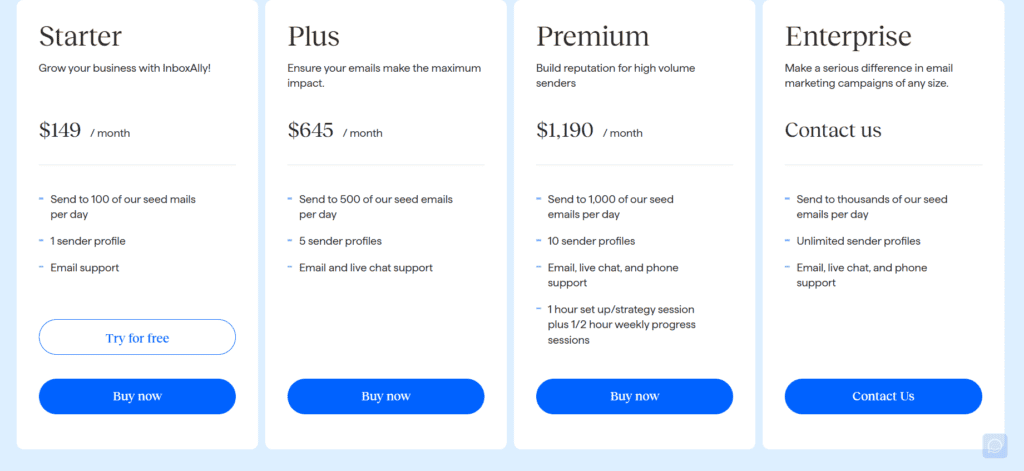
InboxAlly’s lowest-tier ‘Starter’ plan costs $149 per month. This includes one sender profile, email support and the ability to send to 100 of its seed mails per day.
The ‘Plus’ tier costs $645 per month and includes support for 500 seed mails, five sender profiles and email/live chat support.
The ‘Premium’ and ‘Enterprise’ plans include extra features like extra profiles, phone support, and strategy sessions. Premium costs $1,190 per month. You need to contact InboxAlly’s sales team for a quote for the ‘Enterprise’ plan.
Take a look at our full InboxAlly Review Here!
3. GlockApps
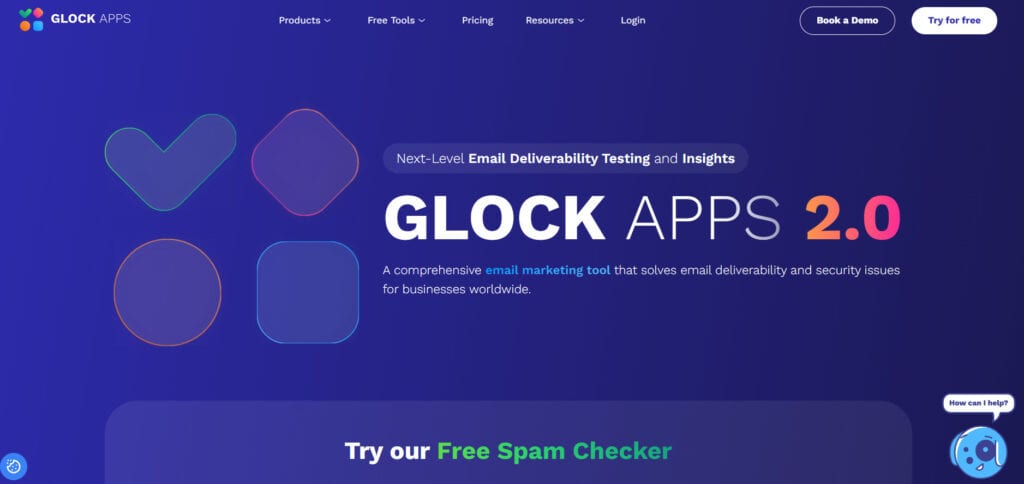
Key Features:
- Free spam checker
- Monitors domains against 50+ industry blocklists
- Authentication checks (SPF, DKIM, DMARC)
- API access and customizable reporting options
True to its name, this platform represents a suite of tools designed for better email deliverability.
‘Inbox Insight’ can perform tasks like checking your email deliverability across major ISPs using the most popular filtering tools like SpamAssassin. It can also monitor your domain and provide a summary of your email performance and DKIM record alignment. This includes your IP’s sender score, so you can see how its reputation is improving.
‘DMARC Monitor’ also works to protect your email domain by providing reports of any suspicious activity. This includes free DMARC, DKIM, and SPGF monitoring every two hours.
The ‘Uptime Monitor’ is designed to keep your business website running, so it can notify you if your server or IP gets blocklisted.
Who it’s for:
Any agencies, email pros, or businesses that need detailed diagnostics and round-the-clock monitoring, especially those managing very complex email infrastructures.
Pricing:
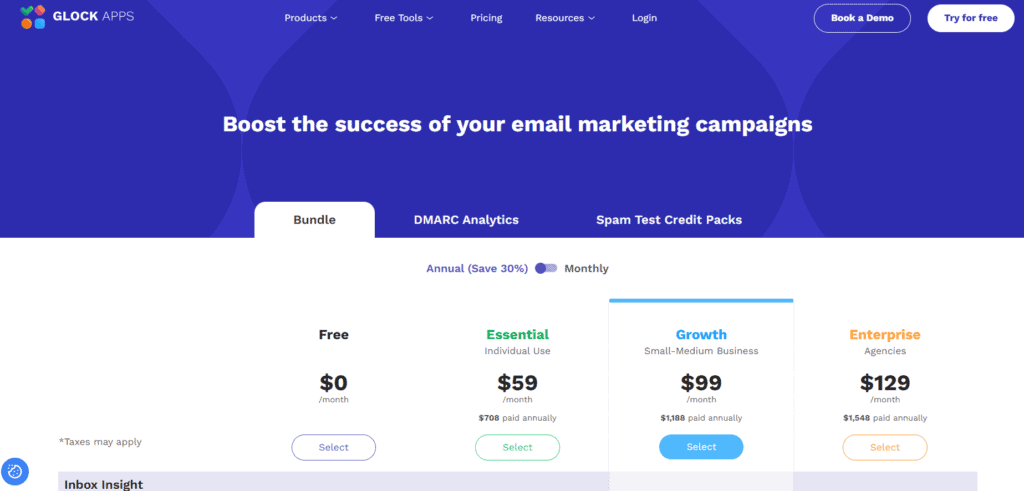
Glockapps has a free plan that includes a sending account and two spam test credits. You’ll also benefit from up 10,000 DMARC messages and a single IP reputation monitor.
The ‘Essential’ plan costs $85 a month and is designed for individual use. It includes 30 spam test credits, 50,000 DMARC messages, and 10 IP reputation monitors.
The ‘Growth’ and ‘Enterprise’ plans are designed for SMBs and Agencies. They cost $142 and $185 per month respectively, and support 10/20 sending accounts. Both tiers support a huge number of DMARC messages (100,000 and 1 million respectively) and 20/25 IP reputation monitors.
Subscribers can get a 30% discount if they pay annually. There’s also a free trial, though the main site doesn’t say how long it lasts.
4. Folderly
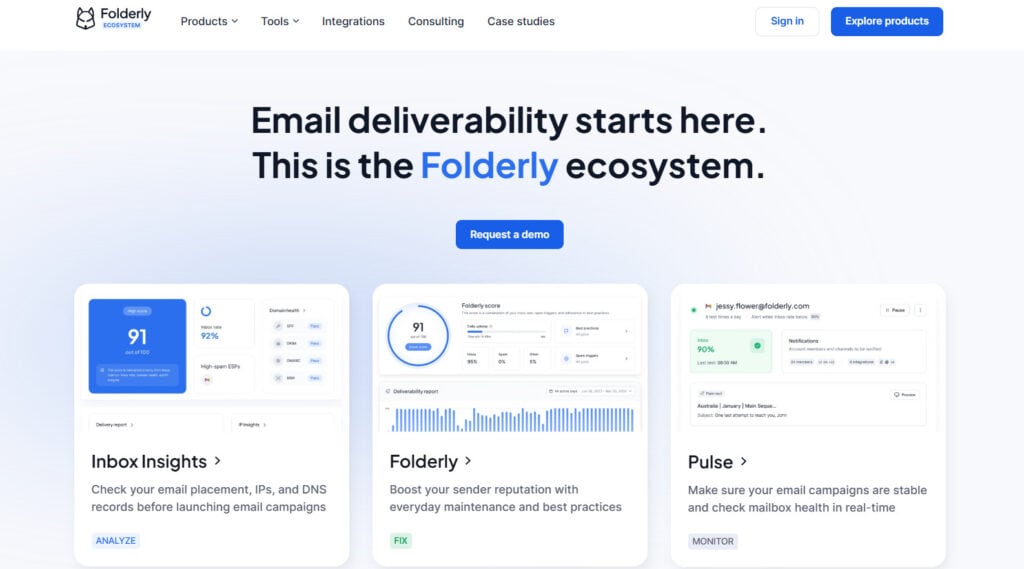
Key Features:
- Detailed deliverability monitoring
- Spam triggers
- Best practices suggestions
- AI-powered insights
Like GlockApps, Folderly represents an ‘ecosystem’ of tools. For the purposes of this review, we’re focusing mainly on the Folderly app itself. This said, its ‘Inbox Insights’ component is extremely useful for generating detailed email placement reports, as well as running automated tests and receiving IP insights.
Returning to the main product, this is probably the ideal tool if you’re just starting to launch email campaigns. This is because of the way in which it delivers succinct summaries and actionable tips for messages you prepare. It can also use AI to suggest amendments.
Special mention should also go to the main dashboard, which can provide an easy to understand ‘Folderly score’, which is calculated using factors like your inbox rate, spam triggers, and adherence to the tool’s suggested ‘best practices’.
If you have multiple mailboxes, the score can also be displayed next to these using helpful color coding: lower scores are in red and amber, while higher scores are in blue.
Who it’s for:
All marketers and businesses who are looking for an intuitive solution with proactive monitoring.
Pricing:
While Folderly itself is fairly reasonably priced, many of its competitors include the same features as ‘Inbox Insights’ without having to pay for a separate subscription.
Assuming you’re happy to sign up for Folderly alone, you’ll pay either $120 per mailbox if paying monthly or $96 if you pay annually. You can also benefit from up to two free tests with Inbox Insights.
The ‘Folderly’ ecosuite also includes a free tool named ‘Pulse’, which you can use to monitor spam placement, then receive free alerts via Slack, email, or SMS.
Choosing the right alternative
Although all the above listed tools are excellent alternatives to MailMonitor, at the end of the day you need to find one that’s the right fit for you. As you decide, consider the following factors:
Your primary challenge
In other words, what are you struggling with the most? Is it warming up new domains? Or perhaps it has more to do with inbox placement or sender reputation. Your answer will help inform the best platform for your needs.
Scale and complexity
If you’re juggling multiple domains for enterprise-level operations, you’ll likely need advanced diagnostics and continuous monitoring. Smaller campaigns usually only require much simpler tools.
Integration requirements
Simply put, does your chosen tool work with your current email provider? You should also check your chosen platform’s supported mailboxes so you can be sure of reaching your intended target audience.
Your budget
Your chosen platform may well offer every feature an email marketing campaign would ever need, but this is beside the point if it’s outside your budget. Consider the different pricing plans for the above listed MailMonitor alternatives carefully. There’s no point in paying for features you don’t use. Some platforms operate on a volume-based pricing model, which may offer better value for money as your business grows.
Support and reporting
The ideal platform will provide just the right amount of actionable feedback for your campaign needs. If you run into trouble, check the type of support offered e.g. email only or live chat/telephone. The best platforms can help with issues 24 hours a day.
Final Thoughts
The best MailMonitor alternative for your email campaigns depends very much on your own workflow and deliverability challenges.
- InboxAlly stands out from its competitors, as it has a proactive approach to inbox ‘training,’ meaning it’s the perfect choice if you want to rescue your latest email campaign from the spam folder.
- If you need extremely detailed insights as well as more comprehensive monitoring, you can also consider the GlockApps suite provided you’re happy to switch between multiple tools.
- If you’re new to email marketing, then tools like Warmy and Folderly have excellent automation features. They can also review your templates and make sensible suggestions to improve your deliverability rate.
By focusing on this select group of proven MailMonitor alternatives you can trust that you’re going to choose a platform that will maximize both your email reach and campaign performance.
If you’re considering other tools, remember to avoid any marketing hype or unverified claims. Where possible, take advantage of free trials and read independent reviews to ensure that your chosen alternative meets all your business needs.
InboxAlly is the comprehensive suite I need to solve challenging deliverability problems across the board. It's like a triage hub for diagnosing and fixing email deliverability rates in one dashboard. I've tried a lot of tools, but this is the one I've stuck with.


